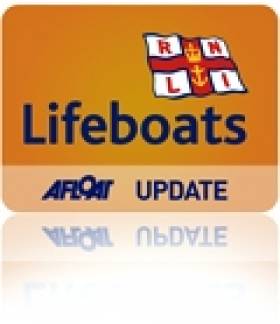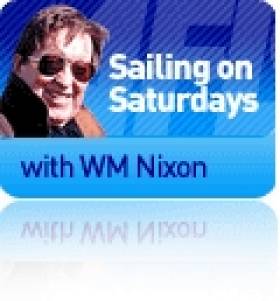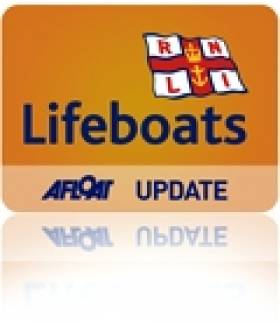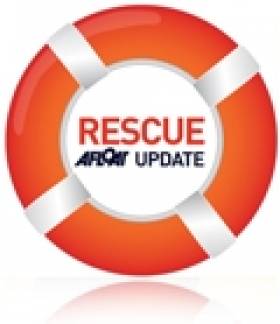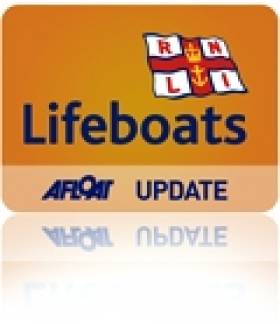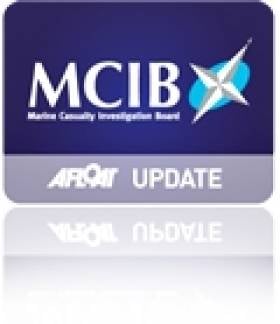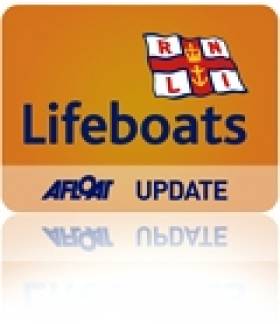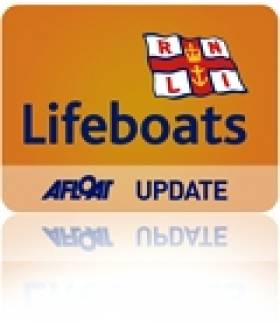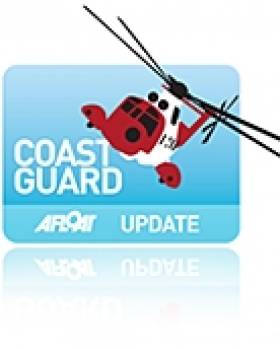Displaying items by tag: Rescue
#RNLI - Arranmore RNLI was involved in an epic 12-hour rescue in difficult weather of five fishermen on board a crabber which got into difficulty on St Patrick’s Day.
The station’s all-weather lifeboat was launched at 1.45pm to go to the assistance of the 15-metre fishing vessel which had lost power some 40 miles north west of Arranmore due to a rope getting tangled in the propellers. The five crew members on board the boat were not in immediate danger.
Arriving on scene at 4.30pm, the lifeboat crew, under second coxswain Jimmy Early, established a tow line and proceeded to escort the stricken vessel into Burtonport. However, due to a heavy five-metre swell, the journey was slowed down by the tow line breaking.
Arranmore RNLI volunteer lifeboat press officer Nora Flanagan said: "This was a long callout for all concerned, but our lifeboat crew was delighted that they were able to assist the five crew members and bring them and their fishing vessel safely to shore which they did shortly before 2am this morning (Monday 18 March)."
This was the first long-haul callout for Arranmore’s newest and youngest crew member, 17-year-old Dominic Boyle. The second youngest crew member - Leigh Early, son of coxswain Jimmy - was also on the call.
Meanwhile, three crew members from Courtown RNLI have been presented with animal welfare awards for their bravery in rescuing a woman and her dog from Courtown Harbour last December.
As previously reported on Afloat.ie, the 29-year-old woman got into difficulty when she attempted to rescue her Jack Russell, Holly, from the freezing water off Courtown pier.
The North Wexford Society for the Prevention of Cruelty to Animals (SPCA) awarded David Switzer, Aine Stafford and Fintan O’Donoghue for their efforts in rescuing the woman and her dog.
Colin Webb, chairman of the animal welfare group, said the society took strength from seeing examples of great compassion towards animals in the community.
Abandon Ship! The Rescue of the Crew of Wolfhound
#wolfhound – Abandon ship!!! Complete with its insistent screamers (that's exclamation marks to you and me), it's such a hoary old nautical cliché that when it happens, you expect awesome background music to roll, with the blackest of black clouds overhead tearing apart to reveal some majestic and divine portent.
But the reality these days is that with well-established International Laws of the Sea in place, and time-tested global rescue procedures working effectively supported by the latest in basic emergency radio communication, once it has moved beyond a life-and-death situation with the rescue achieved, it very quickly becomes a humdrum matter of filing reports, completing forms, and submitting to official enquiries.
Such routine is important for everyone, and not least the rescued. It puts their experiences into perspective, it makes them realise that what has happened to them is not horribly unique, and it gives them a reasonable feeling that while they have suffered an acute personal setback, perhaps it can now be of some benefit to others. By slipping into established post-rescue formalities and analysis, the process of mental and physical recovery can be quietly begun.
Obviously the situation is completely different if there has been loss of life. But happily, in the matter of the rescue of the crew of four from the Irish-owned Swan 48 Wolfhound 70 miles off Bermuda on the morning of Saturday February 9th 2013, apart from one non-acutely wounded hand, there was no serious injury involved. So we can now examine how a very attractive project to take part in the sun-filled RORC Caribbean 600 Race in a fine 12-year-old Swan 48 newly-purchased in New England, and subsequently sail the boat home across the Atlantic to Ireland after cruising the Caribbean, became so totally unravelled in an extreme winter storm in the Gulf Stream.
Alan McGettigan (52) has made his career in the oil and gas exploration business. One of the founders of successful frontline operator Petroceltic, his work has taken him to harsh and volatile places which, if they weren't already dangerous to be in at the time, inevitably became dangerous with their added strategic significance when his prospecting was successful. It was a working life outside normal comfort zones, so as a sailing enthusiast – when he could get the time – he also pushed the limits of the possibilities in cruising.
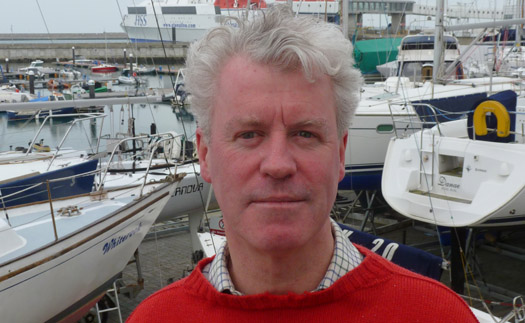
Alan McGettigan in Dun Laoghaire 27/02/13 Photo: W M Nixon
A dozen or so years ago, he bought a Ron Holland-designed Swan 43 which he called Wolfhound. Though time was initially limited, six years ago he began a long-term cruise aimed at circumnavigating western Europe, beginning with a west-east transit of the Mediterranean in which – unusually – he focused in the early stages on the coast of North Africa.
Being very much part of the Dun Laoghaire sailing community, he has like-minded friends – many of them boat-owners themselves – to make up a crew panel on which he could draw for congenial ship's company, people who in turn were enthused by his interest in going to unusual places. Despite the turmoil in the region, with each succeeding season Wolfhound found herself getting further east, and in time she explored the Black Sea in some detail before – in the summer of 2011 – she shaped her course into the Danube.
But after the worst drought in a hundred years, the great river's levels were so low that Wolfhound's draught prevented them getting any further than fifty kilometres upriver, so they returned to the Black Sea coast, and arranged to lay the boat up afloat for the winter in the attractive Romanian port of Constanta. But then in November, too late to move to another port, Alan had a call from the harbour that they required Wolfhound to be lifted out and laid up ashore, for which the yard would provide the cradle.
Although he preferred her to be afloat in the sheltered little marina, he flew out and supervised the transfer ashore. Then in January the yard was in contact again to say that an extreme winter storm was moving south from Siberia, and there was a danger that boats ashore on the quay would be engulfed in snow and ice. But the weather was already so bad that Constanta airport was closed down. So Alan could do nothing but await the worst as the yard emailed him photos which showed Wolfhound disappearing under her own private iceberg which eventually weighed more than ten tonnes. The cradle collapsed, and the boat sustained further serious damage in falling on her side under yet more snow and ice.
Although badly damaged, she was repairable, yet she would only be acknowledged as a proper Swan if the repairs were done by Nautor Swan themselves in Finland. But that process with its long transportation would be prohibitively expensive. The insurers preferred a yard they'd found in Bulgaria. Eventually, the stalemate was broken with a deal in June, the insurers paying up the insured value, and keeping the damaged boat.
So Alan found himself boatless in June 2012, but with an unexpected accumulation of significant boat-buying resources, as he sold up his shareholding in Petroceltic in 2012. The world was his oyster, or rather his Swan, and he toyed with the idea of an attractive readily-available Swan 60 in the south of France, and a Swan 651 in the UK.
But this resulted in a certain thoughtful sucking-in of the breath among his regular crew panel. They pointed out that if he was seduced into going above a certain size, their cosy all-friends-together-as-equals arrangement would almost certainly be disrupted by the need to carry professional crew, particularly if the boat was going to be moving around exotic and distant locations.
Those of us who mess about in smaller boats are happily untroubled by this critical change of boat management requirements above a certain size. Indeed, it's a problem for which most of us would have scant sympathy. But it is very real for those who have the means and inclination for a larger boat in which they can really cover the ground and get comfortably, if somewhat impersonally, to distant places, if they're prepared to go with the potentially disruptive presence of professional crew making them feel like passengers on their own boat.
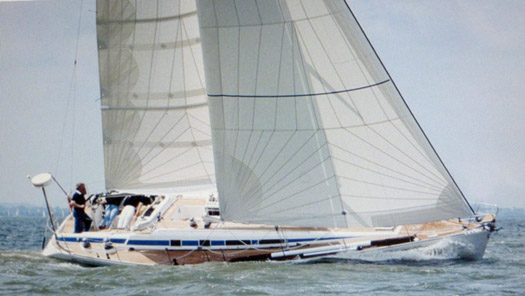
"A modern Moonduster". The Frers-designed Swan 48 is nearly 50ft long, and is an up-dated glassfibre sister of Denis Doyle's famous Moonduster
By September 2012, however, things were back on track with the location of a 12 year old Swan 48 in Connecticut. Originally designed by German Frers in 1994, the boat is actually just a matter of inches under 50ft LOA, which made her the equivalent of an up-dated production version of Denis Doyle's legendary Moonduster. As one of the senior members of the eclectic McGettigan Crew Panel had sailed many successful races with The Doyler on The Duster, it was reckoned that this was all as it was meant to be, as it offered the additional prospect of an immediate season or two in the Caribbean with a boat which was of a size to be still manageable without a professional crew.
This also offered the possibility of racing the Caribbean 600 in February 2013, an attractive idea as the boat came with a formidable wardrobe of sails. But if that aim was to be comfortably fulfilled, the boat had to be ready to sail south to the Caribbean in November, when fleets of boats make the journey south from New England as soon as the hurricane season is over.
However, with Superstorm Sandy wreaking havoc in the New York coastal area in September, it was impossible to bring things to fruition as quickly as hoped. Despite the shared language, buying a boat in the US can be much more difficult than buying one in Europe. And as you finally do close the deal, you are already discovering that boats in America, while seemingly identical to their sister-ships in Europe, can often carry very different equipment.
So the programme slipped, but by late November Alan was doing sea trials on Long Island Sound with a surveyor, and by early December he had been given a favourable report, and negotiations were drawing towards a conclusion through a broker with an owner - never personally met - who lived in another distant American state.
Finally, with the seller faced with the exigencies of the end of the tax year on December 31st, the deal was concluded on that last day of 2012. Meanwhile, back in Ireland over the Christmas/New Year holiday, the crewing arrangements were firmed up between those who were to do the delivery passage in late January/early February from Connecticut to the Caribbean via Bermuda, those who then wished to do the Caribbean 600 Race on February 18th, and those who would cruise the islands afterwards.
It was a very busy time with the new boat, now re-named Wolfhound, being transferred to Irish ownership with details like the IRC rating being re-issued by the ISA. But on 25th January Alan and three long-time shipmates arrived in Connecticut knowing that the weather prospects were bad with Snowstorm Nemo developing over the northeast United States, but equally knowing that a favourable weather window would follow it.
However, they knew there were some days of work to be done in any case before they could sail, and by the time that was completed the economy of Connecticut had benefited from the Wolfhound campaign by a significant amount. As expected, a new top-of-the-range Viking liferaft had to be installed, but less clearly expected was the necessary acquisition of a new Zodiac inflatable tender and outboard, and completely inexplicable was the need to install a new Charger/Inverter, the original having disappeared. The boat, in other words, was not precisely as Alan remembered her from the last time he'd seen her in early December, but with goodwill all round she was made ready for sea.
Thanks to friends in the Cruising Club of America, Alan and his crew had a briefing session with people well used to sailing the 650 miles to Bermuda at 1215 on Saturday 2nd February, and at 1530 hrs they headed out round the northeast end of Long Island and shaped their course parallel with the American coast towards Cape May in order to slip between weather systems and get in to more clement conditions as quickly as possible, for though the winds were favourable northerlies and easing after the storm force winds of Nemo, the temperature was minus 8.
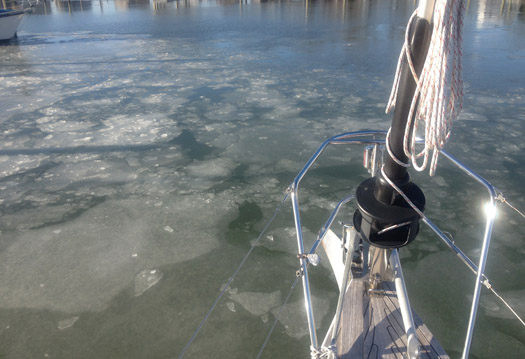
Getting through the ice departing from Connecticut on the afternoon of Saturday February 2nd. As darkness drew on, the temperatures plunged. Photo: Alan McGettigan
In such conditions, it was so cold that they motored with only the mainsail set, and put in watches of only half an hour. But progress was good and through Day 2 (Sunday February 3rd), everything was going according to plan, they were finding their weather window, and it was even getting slightly – just very slightly – warmer, as by now the wind was easterly, though as it was 30 knots with some gusts to 50 knots it was by no means the "champagne sailing" they'd been promising themselves once they got down to Cape May.
By Monday morning conditions permitted one hour watches and soon they were sailing properly, but there was concern about a new weather system developing to the eastward in the tail of Storm Nemo. However, satisfactory progress was being maintained and they were able to move up to two hour watches with half hour rotations. The going was good, but that was as good as it was to get. In order to keep up battery power, they tried to put the new Mastervolt Charger/Invertor into service on the remote setting, but the indicator light failed to show. This was serious. They were halfway through the passage to Bermuda, but knew that unless someone aboard suddenly discovered his own previously unrevealed genius as an electrical and electronics engineer, by Day 4 (Tuesday February 5th), all systems except the engine would be down through lack of power – this duly happened at 0350hrs on the Tuesday.
They were now halfway between the American mainland and Bermuda, but with the frequently changing wind by this time from the west, it didn't make sense to try to beat for the Chesapeake as the nearest mainland all-weather port of refuge, even if Bermuda is a place difficult of access. So they pressed on, but later on the Tuesday the engine failed to re-start. It was found that it could be run intermittently, and as it had been serviced before leaving, the suspicion was that grunge in the fuel tank – the boat had been effectively out of commission for more than a year – was causing fuel blockages, so they made do without the motor, as any use would only make the blockage problem worse, and maybe damage the engine.
Their situation was seriously unpleasant, for although cooking had been by gas, the top-of-the-line American marine cooker relied on an electrically-powered safety switch for its ignition. So for the time being they endured cold food – mostly breakfast cereals and fruit – and resisted the temptation to cut the gas line and by-pass the safety connection to the stove, though without heating of any sort and only cold food, the effect on morale was dire.
By now they were getting into very bad weather again with huge seas and rising winds, and on Day 5 (Wednesday February 6th) the furled headsail (it was the Number 4) was simply shredded by the strength of the wind despite being rolled. But conditions had eased enough the following day to get the remains down and cleared from the forestay.
Despite everything, they were getting near Bermuda, for even with their problems they had averaged 5.5 knots from Connecticut. But the weather was once again deteriorating, and now their sense of being cut off from all assistance was exacerbated by the discovery that their hand-held VHF was completely discharged, even though it had been fully charged ashore prior to departure, while their location was too remote for personal mobiles to be of any use.

So near and yet so far.....Wolfhound's route towards Bermuda
So with all systems down, visibility very poor and conditions deteriorating, with the vessel getting a horrendous pounding with a couple of knockdowns and chaotic dislocation below to such a degree that it was safer to remain on deck, the only navigational information available was through a single iPad which was already down to 15% power. But even if they could find their way the final fifty miles to Bermuda, they had no engine power to get through the intricate reefs and St George's Channel.
Throughout all this, Alan recalls that he never heard a voice raised in anger or frustration – he had shipmates to cherish. And that's what he did. He cherished them. Much and all as he'd had great hopes for his new boat, he decided that the risks to life and limb in trying to make the final rock-strewn miles to Bermuda were simply too great. It was a choice of putting his friends' lives at great risk, or abandoning ship. It was no contest. He activated the EPIRB at 1530 hours on Friday February 8th.
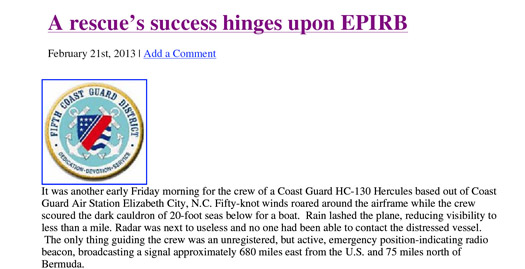
The offiial US Coastguard report into the rescue is downloadable below as a PDF document
As the American authorities couldn't immediately trace the registration of the EPIRB (see downloadable PDF of Coastguardnews below) they didn't at first know what they were looking for, but that Friday night, Wolfhound was located in darkness by a US Coastguard C130 Hercules aircraft from Norfolk, Virginia, which dropped emergency supplies and more importantly indicated to them that help was on the way. Meanwhile Bermuda MRCC instructed two ships in the area, the Empire Champion and the Tetien Trader, to alter course towards Wolfhound.
The Empire Champion was unladen, which made manoeuvring in the extreme weather difficult, but the fully-laden Greek ship Tetien Trader arrived at dawn on Saturday February 9th and did the job. Floating deep, she provided an almost rock-like base onto which the crew of Wolfhound, which was alongside with long warps fore and aft, could be hauled aboard by the sheer brute strength of eight men pulling on a heavy warp which the Irish crew had to tie round themselves using a bowline knot.
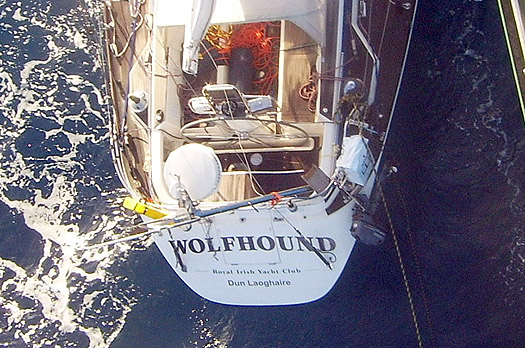
The chaos of Wolfhound's cockpit seen as she lay briefly alongside Tetien Trader during the rescue. Photo: Alan McGettigan
Throughout all this, in a cruel twist the sky had temporarily cleared and there was even a hint of sunshine before the next wave of bad weather closed in again later in the morning, During the rescue, the yacht was rising and falling fifteen to twenty feet up the steel side of the ship, but after the crew had been hauled to safety, the extreme conditions soon snapped the warps holding Wolfhound alongside, and she drifted away. She was not seen to sink, as some reports have suggested, and might even be still out there, alone on the ocean. Her crew meanwhile headed east across the Atlantic on the Tetien Trader, and were landed at Gibraltar on Wednesday February 20th.
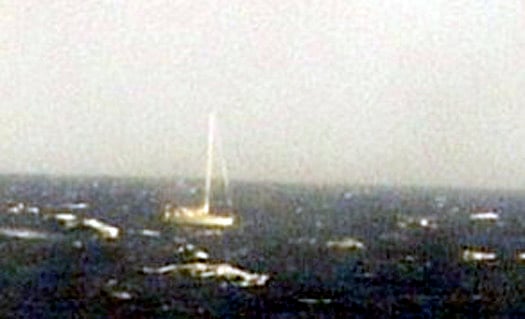
Last glimpse of Wolfhound from Tetien Trader before the weather closed in again. Photo: Alan McGettigan
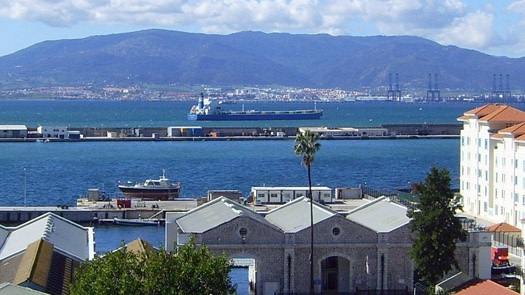
Journey's end. Tetien Trader in Gibraltar on February 20th. Photo: Alan McGettigan
As for what might be learnt from this sad story, that can be analysed in due course, but all that can be said this morning is that it could have been much worse. No lives were lost, nobody was seriously injured. In extremis, the right and proper priorities were observed. Life can go on. Indeed, it was going on almost immediately. On the Transatlantic passage on the Tetien Trader, Declan Hayes was moved to pen some poetry:
Wolfhound (the adventures of Alan, Morgan, Declan & Tom)
Dublin, Boston, then Bermuda bound
To start our journey on the new Wolfhound
Tortola, Antigua, Azores and home
Cutting through the Atlantic foam
It was oh so very, very cold
As we set out on our journey bold
Dreaming of the warm Gulf Stream
And the Caribbean sun on our beam
But that was never going to be
As we battled wind and heavy seas
All power went and food was low
As we were battered about in the merciless blow
We signalled help by satellite
But no help came until the night
The drone of engines in the sky
Then searchlights allowed them us to spy
By daylight two ships had answered our call
But we could not board due to swell and squall
Persistence paid and one by one
We were hoisted aboard, it was no fun!
Wolfhound crashed against the mighty hull
Then broke her lines with a mighty pull
She drifted past the stern abeam
The end of Alan's epic dream
Aboard the ship, the Tetien Trader
Our lives intact, disappointment faded
A nicer crew you could not have chosen
The captain, cook, not least the bo'sun
Ten days we spent on that good ship
Before they let us off at the Rock of Gib
A trip I doubt we will ever forget
So very different from travelling by jet!
The moral of the story is plain to see
You never know what's going to be
Life is precious and full of hope
A boat's just plastic, metal and rope
Time will pass and memories fade
But the experience is there, forever made
Another part of who you are
Another story for the bar!
Comment on this story?
We'd like to hear from you on any aspect of this blog! Leave a message in the box below or email William Nixon on [email protected]
Kilrush RNLI Rescues Five From Stranded Boat
#RNLI - Kilrush RNLI launched on Thursday afternoon (21 February) after pagers were set off by Valentia Coast Guard to the Foynes area, where it was reported that a boat had lost engine power with five people on board.
Within minutes the crew assembled and set out to the location to investigate. Within 25 minutes they located the vessel and quickly set up a long tow. Tides were running and weather conditions were reaching force 7 to 8.
For their safety the five men were taken on board the lifeboat, while a lifeboat crew member was transferred onto the casualty vessel to oversee the tow. On establishing that the men were fine, the lifeboat proceeded to Tarbert Pier. At this stage the Irish Coast Guard helicopter Rescue 115 from Shannon was also on scene.
Within an hour the Kilrush RNLI lifeboat reached Tarbert Pier, where the lifeboat crew assisted the men in tying up their vessel.
Lifeboat helm Tom Blunnie praised the work of his crewmen in this rescue, stating that “under such conditions it’s great to know that our training pays off when calls like this occur.”
The crew on the day were helm Tom Blunnie, Pauline Dunleavy, Fintan Keating and Charlie Glynn.
Five Rescued From Stranded Fishing Vessel Off West Cork
#Rescue - The Irish Times reports on the rescue of five fishermen of West Cork this morning (21 February) after their fishing trawler was stranded in strong coastal winds.
RNLI Castletownbere's lifeboat crew responded to the trawler Anders Nees after its propeller fouled some 6km south of Bere Island in the early hours.
The stricken fishing boat was subsequently towed back to Castletownbere.
Portrush Lifeboat Rescues Stranded Kayaker
#RNLI - Portrush RNLI has rescued a kayaker who got into difficulty off the Co Antrim coast.
The volunteer lifeboat crew had an early call out on Sunday morning (17 February) to the kayaker who got into trouble on the water at West Bay.
There were strong southerly winds at time which caused a swell. The kayak capsized and was whipped by the prevailing wind into the harbour area, leaving the kayaker stranded and treading water.
A Portrush lifeboat crew member who witnessed the scene on the West Strand spotted the incident and promptly raised the alarm.
The inshore lifeboat crew - including Mark Mitchell as helm, Andy McClelland and Stevie Ritchie - launched within minutes and had the kayaker back at base within 20 minutes.
Portrush RNLI lifeboat operations manager Robin Cardwell said: "The kayaker was very fortunate as the winds were quite strong in the West Bay. Our volunteer crew launched quickly and was able to bring him back to shore safely."
Man Lost Arm After Going Overboard from RIB In Cork Harbour
#MCIB - A man who lost his arm when he fell overboard from his boat in Cork Harbour last summer could have avoided the accident if he had followed essential safety precautions, according to the official report into the incident. The full report is available to download below as a PDF document.
Owen Corkery of Carrigaline was the subject of a 'miracle rescue' on 9 June 2012 when he was thrown overboard from his RIB, which subsequently struck him several times after he entered the water near Haulbowline Island, causing serious injuries to his head, back and left arm.
As previously reported on Afloat.ie, the RNLI said Corkery was "incredibly lucky to have been spotted from the shore" by a man now known to be Paul Bryans, who had been looking through a telescope at Fort Camden in Crosshaven approximately a mile away from the site of the incident.
Bryans and colleague Dick Gibson immediately raised the alarm with the emergency services and Crosshaven RNLI respectively, and rescue crews were dispatched within minutes.
While the lifeboat volunteers took control of the wayward RIB, Corkery was quickly retrieved from the water by the crew of the Cork Harbour Pilot boat Sonia. They found him incoherent and bleeding heavily, and also noted that while he was wearing a working personal flotation device (PFD), he was not wearing warm clothes or shoes.
Corkery was transferred via ambulance to Cork University Hospital, where his left arm was later amputated just above the elbow due to the severity of his injuries.
According to the official report into the incident by the Marine Casualty Investigation Board (MCIB), the RIB was found to be undamaged but had no CE or other approval mark.
The kill cord on the boat's motor was also found to be malfunctioning, as the engine could be started whether or not it was attached, and did not shut off when removed.
The report states that Corkery - an experienced powerboat user who had not completed any recognised handling course - has since explained he was aware of the kill cord malfunction but continued to use the vessel.
He confirmed in the same interview with investigators that he was standing beside the helm of the RIB at the time of the incident, a position that "would have made him considerably more likely to be thrown from the vessel".
Investigators also found it likely that Corkery's lack of shoes would also have reduced his grip while standing on the floor of the RIB.
In its conclusions, the MCIB report - which is available to download below - emphasises that the kill cord is an "essential part of safety equipment for all open motorboats" that should always be used and checked regularly, and that the helm of any high-speed watercraft should always remain seated, even at low speeds.
It also recommends that all pleasure craft owners should complete a recognised powerboat handling course.
Irish Yachtsmen Rescued From Stricken Vessel Off Bermuda
#Wolfhound - Four Irish yachtsmen have been rescued from a recently purchased vessel some 70–miles north of Bermuda after it suffered both power and engine failures amid stormy conditions off the northeastern United States.
The 48-foot Swan class sloop Wolfhound, purchased recently by owner/skipper Dalkeyman Alan McGettigan, had departed from Connecticut on 2 February en route to Antigua in the West Indies to compete in the RORC Caribbean 600.
As WM Nixon wrote on Afloat.ie recently, the Wolfhound was expected to eventually call Dun Laoghaire home following its Caribbean adventure.
But according to Bermuda's Bernews website, trouble began when the vessel reportedly suffered a loss of battery power due to the failure of a new inverter charger some 400 miles off the Delaware coast.
This was followed by engine failure a day after departure which left the vessel without communications or navigation systems for eight days.
Between Friday and Saturday the boat reportedly suffered two knockdowns in treacherous weather on the heels of the midwinter storm that recently battered America's northeastern states, and which led McGettigan to activate the on-board emergency beacon.
After a fruitless search by US Coast Guard aircraft, the yachtsmen were eventually located by and transferred to a passing cargo ship, Tetien Trader, which had joined the search effort.
The Wolfhound later sank some 64 miles north of Bermuda.
McGettigan's crew from the Royal Irish Yacht Club in Dun Laoghaire have been confirmed by the club's sailing manager Mark McGibney as Declan Hayes and Morgan Crowe.
Tom Mulligan of the National Yacht Club has been named locally as the fourth crew man on board.
A source close to Afloat.ie says that Hayes telephoned home from the Tetien Trader and confirmed he and the others were being "well looked after" by the Greek crew of the cargo vessel, which is due to land in Gibraltar on 19 February.
A member of the RIYC, Alan McGettigan is an experienced offshore skipper, previously sailing in areas as far afield as the Baltic Sea, the Caribbean, the South China Sea and the Mediterranean, and having competed in past Round Ireland and Dun Laoghaire to Dingle (D2D) races, most recently in the yacht Pride of Dalkey Fuji.
RNLI Calls For Causeway Coast Lifeguards
#RNLI - The RNLI is currently recruiting lifeguards to work on 10 Northern Ireland beaches for the forthcoming season including seven beaches along the Causeway Coast.
The successful candidates will become part of the RNLI’s beach lifeguard team who will monitor and advise the public of any dangers or hazards and carry out rescues.
The charity provides a seasonal service on seven beaches along the Causeway Coast including Benone, Downhill, Castlerock, Portstewart Strand, Portrush West Bay & East Strand and Whiterocks.
This is the third year the lifeboat charity’s lifeguards have provided a lifeguard service in Northern Ireland, offering beach-goers and water users a seamless rescue service from the beach to open sea working alongside RNLI lifeboats.
The closing date for applicants is Sunday 17 February 2013. A detailed description of the RNLI lifeguard role is available at www.rnli.org/lifeguards.
A key part of an RNLI lifeguard's job is to spot dangers before they develop, and 95% of their role is preventative. Their presence on the beach provides reassurance to the public while also offering any help or advice to help people enjoy their beach experience in a safe environment.
To many beach users they are a reassuring presence but they also carry out many other important functions. They assess the conditions on the beach and place zone flags and warning signs to advise the public. They carry out rescues to help people who have got into difficulty in the water or who need assistance. They also provide first aid, help with lost children, give advice, report hazards, and assist with beach safety and education programmes. They train and preform to their duties to the highest RNLI standards.
The RNLI has about 50 positions available and many former lifeguards are expected to return for the new season. However, there are a number of positions vacant and the charity would like to hear from interested people. The minimum age for applicants is 16 years and candidates must have a high level of fitness.
Mike Grocott, RNLI lifeguard manager for Northern Ireland, said: “RNLI lifeguards are a vital part of the charity’s lifesaving service. Last year they dealt with 126 incidents and assisted 142 people on the Causeway Coast.
"It is a fantastic opportunity for people to do a job that is both fulfilling and enjoyable. Our lifeguards speak to hundreds of people over the course of the season and get the opportunity to do something important and rewarding in the community.
"The ideal applicant will already hold an International Lifesaving Approved Beach Lifeguard Award but if candidates need to get qualified we can put them in touch with local providers of courses.”
Limavady and Coleraine Councils along with the National Trust provide funding towards the lifeguards’ wages while the RNLI funds the training and equipment.
Lifeboat Rescues Windsurfer In Stormy Conditions
#RNLI - Kilkeel RNLI rescued a windsurfer who got into difficulty in Carlingford, Co Louth yesterday (Tuesday 29 January).
The charity’s volunteer lifeboat crew was requested to launch by the Irish Coast Guard shortly after 2pm following a report that a windsurfer had got into difficulty in Carlingford Lough.
Launching their inshore lifeboat immediately, the crew encountered very unfavourable weather, with strong westerly winds of between force six and seven.
The lifeboat proceeded up the lough where they found and retrieved the windsurfer who had stayed by his board. The crew then attempted to retrieve the sail and board but couldn’t due to the windy weather conditions. They instead proceeded to tow the board into Greenore where the local coastguard took over.
Despite being in the water for approximately an hour, the casualty was described as being in reasonably good health.
Roy Teggarty, Kilkeel RNLI lifeboat operations manager, paid tribute to the lifeboat crew for their efforts in what was a challenging rescue:
"This was a day with difficult conditions because of the strong winds," he said. "It was mainly difficult to keep the lifeboat steady when retrieving the casualty so this rescue involved expert boat handling by all involved."
Coastguard Helicopter In Double Rescue On Sunday
#Coastguard - The Irish Coast Guard's Waterford-based rescue helicopter recovered two casualties in separate incidents on Sunday, according to the Irish Examiner.
One fisherman was retrieved from the French fishing vessel Larche some 50 nautical miles south of Cork after complaining of chest pains and difficulty breathing.
The man was winched on board coastguard helicopter Rescue 117 and transferred to hospital in Cork for treatment.
In a separate incident, a hillwalker was airlifted from Slievenamon in Tipperary after suffering leg injuries in a fall - the second such accident in the area over the weekend.




























